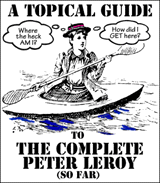
by Mark Dorset
Alan Wachtel contributes this commentary:
In the preface to At Home with the Glynns, Peter Leroy laments that:
My account of my life is unfolding at a slower pace than my life itself. When I first began my personal history, I imagined that at some point I would bring the story of my past up to my life in the present, and a day would come--namely, my sixtieth birthday, as I had it planned--when I wouldn't be writing reminiscences anymore. My story would have brought Albertine and me to Small's Hotel, and I would shift to a running account of life here, writing something closer to a journal than a history, an easier task for my later years. I expected that I would stop telling my story, for the most part, and instead tell the stories of people who stayed at Small's, combined with meditations on the relationship between life in an old hotel and the plumbing in an old hotel. I even thought that I would finally get around to writing that big book about clams, and so on. Now, however, after having put years into the effort, I can see that it isn't likely to happen that way. I now think that in my doddering years I will still be--in the clam bed of my mind, where my imagination lies with my memory and sires countless offspring--a bumbling youth.Peter's frustration recalls the predicament of Tristram Shandy, whose eponymous story Eric Kraft, at least, seems to have read, because he alludes to it in Where Do You Stop? by having Peter and Porky White invent the Captain's Shandy. (And Tristram's Uncle Toby is formally known as Captain Tobias Shandy.) Tristram writes, in Book IV, Chapter 13:
I am this month one whole year older than I was this time twelve-month, and having got, as you perceive, almost into the middle of my fourth volume--and no farther than to my first day's life--'tis demonstrative that I have three hundred and sixty-four days more life to write just now, than when I first set out; so that instead of advancing, as a common writer, in my work with what I have been doing at it--on the contrary, I am just thrown so many volumes back--was every day of my life to be as busy a day as this--And why not?--and the transactions and opinions of it to take up as much description--And for what reason should they be cut short? as at this rate I should just live 364 times faster than I should write--It must follow, an' please your worships, that the more I write, the more I shall have to write--and consequently, the more your worships will have to read.Bertrand Russell pointed out, in Principles of Mathematics (published in 1903), that this is true only if Tristram's life is finite. "Now I maintain," Russell says, "that if he had lived for ever, and not wearied of his task, then, even if his life had continued as eventfully as it began, no part of his biography would have remained unwritten."
Russell calls this the Tristram Shandy paradox. At first sight, of course, immortality doesn't seem to help matters: on the contrary, it only provides an opportunity to fall infinitely far behind (an outcome that most of us can probably identify with). But in fact, for every day of Tristram's life, as Russell shows at great length and degree of abstraction, a year would eventually come in which he could record it. The same, naturally, would be true for Peter.
Likewise, we can map discrete days or other periods of Tristram's (or Peter's) infinitely extended life to discrete words, sentences, paragraphs, pages, or books that record them, by direct one-to-one correspondence. If, on the other hand, we consider time as being continuous, we can still map the days of their lives one-to-one to the years of their writing by a simple projective technique. (Peter's mapping is actually a good deal more complicated, and certainly not one-to-one. But so was Tristram's.)
The difficulty comes when we try to map continuous time to the discrete words, pages, and so on of a book. If time corresponds to the uncountable elements of the real line (cardinality aleph-one), and words and so on to the countable set of integers (cardinality aleph-null), then infinitely many instants must inevitably be lost, no matter how detailed the infinite record. Everything we can preserve composes only a set of measure zero in the non-denumerable infinity of experience.
E-mail it to me, Mark Dorset.

 Here
are a couple of swell ideas from Eric Kraft's vivacious publicist, Candi
Lee Manning:
Here
are a couple of swell ideas from Eric Kraft's vivacious publicist, Candi
Lee Manning:
